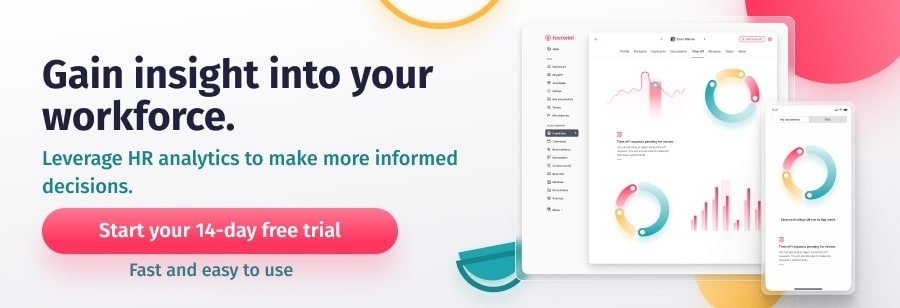Human Resources departments handle a great deal of information such as employee records, salary tiers, complaints, employee turnover rates and much more. This information is used to produce informative and insightful HR reports. These reports highlight significant employee performance information, profile data and business intelligence, which can then be used in future business planning.
Due to the high sensitivity of the information and a large volume of data involved in the creation and management of these reports, accuracy is essential.
- What is an HR report?
- How do you prepare an HR report?
- What are the different types of HR reports?
- What should be included in an HR annual report?
- Why is it important to keep accurate HR reports?
Defining an HR report
Fundamentally, a human resources report is a tool that allows you to visualize a collection of data. From this, you can then analyze and display statistics, insights, metrics and more. The main goal of this is to improve workforce performance, implement better procedures for recruitment, general management, and other important operations within the HR department and the company at large.
The collection of these reports present an overview of all the data that has been gathered within the database. Presented in a clear manner, you can easily decipher from the reports, what is working well and what isn’t. Some reports present trends over time in the form of averages and percentages, whilst others display written statements and descriptions. No matter the kind of report, they all share one main thing in common – assisting in the HR department in making better business decisions. Furthermore, a full hrm report assists the company in improving its functions and delivering better other services in a more streamlined manner.
Although typically reviewed annually, HR monthly and quarterly reports are useful for keeping an even closer eye on workforce developments.
Preparing HR Dashboards & HR reports for Management
Preparing data-driven HR reports can be a difficult task. Not only is it a time-consuming process, but it requires the use of certain specialist software. HR software can help manage documents and improve your ability to keep up with regular reporting.
Although it may still be commonplace to handwrite some reports, digital reports provide greater efficiency and clarity and have become the norm. Viewing everything in one place can be useful to help you map out your company’s future. It’s for this reason, many businesses are creating a digital HR dashboard to display important HR metrics. With HR system software like Factorial, you can automate the process of creating reports. Low-cost software like this which have report creation capabilities are helpful as they present data through visualizations in tables and diagrams, making the information much easier to understand and process. What’s more, advanced dashboards enable future prediction through certain algorithms, which develop with the inputting of more data. This can be very useful for business intelligence and forward-planning.
Not only this, but automated HR metrics dashboards quickly provide a clear, concise and comprehensive report in a matter of minutes. You’ll really be able to see the benefits of automated HR reporting the next time you manage your HR audit.
Types of Reports for HR
There are several types of HR reports that can be adapted according to your company’s needs. It is the job of the HR department to determine which can offer management the most support and guidance.
Here are the top 5 reports your HR department should be using:
- Turnover rate – This report provides both a monthly and annual analysis of the number of employees that have left the business. It can help show managers where improvements need to be made in retaining employees.
- Equal employment opportunity – This analysis offers a comprehensive overview of the personal data of new workers and ensures that standards of equality are being met.
- Excessive absence – With this report, you can observe individual absence patterns, as well as trends over time, allowing managers to follow up on any problems.
- Employee performance – Identify the overall performance of the organization in terms of individual, departmental or sector productivity, sales, earnings or costs. Reviewing employee appraisal data can help in the formulation of business strategies, and meeting future objectives and KPIs.
- Payroll – Comprised of employee financial records. These reports include salaries, bonuses, deductions, and net pay. As workforce pay is typically a company’s largest expense, analyzing this can help keep it regulated and consistent.
What should be included in the report
HR metrics vary according to the industry, business, and location. However, the most common metrics used in HR reports for management include:
- Seniority – Defines the ranks and status of the employees.
- Sex – Determines genders often for diversity purposes.
- Age – Adds to the companies understanding of the profile of their employees.
- Full-Time Equivalent – States the hours worked by a member of staff on a full-time basis.
- Function type – Determines different groups such as top management, middle management, production personnel, and support staff.
- Vacancies – States the anticipated growth and staffing needs for company developments.
- Training costs – Represents the total amount spent on training new employees and the existing workforce.
- Absence – Shows the time employees were absent in the previous month and year.
- Flight risk – Determines which members of staff are likely to leave. An important assessment when recruiting.
Find more information about what to include in your HR analytics reports.
Maintaining Accuracy in Reporting
HR departments handle some of the most confidential information a business has concerning their teams and departments. This information is incredibly valuable, but only when it is accurate. For this reason, it is extremely important that the HR reports for management are as accurate as possible. When the information gathered is accurate, there are a number of benefits to the company:
- Detecting Areas of Concern – Reporting offers an opportunity to track key areas of the business and assess whether they are problematic. Proper reports make detecting issues and finding solutions for them quicker and easier.
- General Management Improvements – Reports inform managers about relevant developments in the workforce, which allows them to have an overarching view of everything that is going on.
- Offer Workplace Metrics – By tracking key metrics, HR managers can closely monitor emerging trends and keep an eye on all aspects of the staff, their movements, performance and more.
- Better Forecasting – An annual HR audit provides important information that can be used for a business’s future decision-making and long-term planning.
The bottom line is, that if data is accurately managed, conclusions drawn from the reports are incredibly beneficial to gaining valuable insights into a company, all of which ultimately lead to their growth. Save time, Automate & Better Manage Your Human Resources Reports.
Contributed by Charlotte Stace; Edited by Tanya Lesiuk




